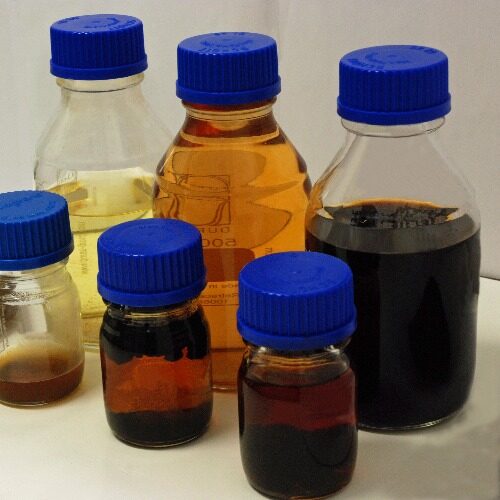
Biomaterials technology group
Leaders
BMTG research and development focus is on biomaterials, techniques and applications in biomedical technology, biorefining and coating technologies. Although conventionally biomaterials are considered for medical devices and equipment, the BMTG research and projects cover a wider range of raw materials, novel biomaterials and applications.
Projects
-
 Tailored solutions for health care and medicine by 3D printing and coating (3DPMED) Finished 01.04.2019 - 30.06.2021
Tailored solutions for health care and medicine by 3D printing and coating (3DPMED) Finished 01.04.2019 - 30.06.2021 -
 3D-Printing Collaboration Project 3DTY - UEF 01.08.2023 - 31.07.2026
3D-Printing Collaboration Project 3DTY - UEF 01.08.2023 - 31.07.2026 -
 Preparatory project for a national joint project on 3D printing Finished 01.06.2022 - 31.03.2023
Preparatory project for a national joint project on 3D printing Finished 01.06.2022 - 31.03.2023 -
 Boosting the bioeconomy of the North Savo area - bioboost project 01.10.2023 - 30.04.2026
Boosting the bioeconomy of the North Savo area - bioboost project 01.10.2023 - 30.04.2026 -
 Biosphere North Savo : Utilization of biomass and biorefining techniques for novel industrial products -development project Finished 01.04.2020 - 31.10.2022
Biosphere North Savo : Utilization of biomass and biorefining techniques for novel industrial products -development project Finished 01.04.2020 - 31.10.2022 -
 Utilization of material analysis, condition control and artificial intelligence for industrial circular economy Finished 01.03.2020 - 31.12.2022
Utilization of material analysis, condition control and artificial intelligence for industrial circular economy Finished 01.03.2020 - 31.12.2022 -
 Developing coatings and surface chemistry for industrial applications Finished 01.02.2019 - 31.07.2021
Developing coatings and surface chemistry for industrial applications Finished 01.02.2019 - 31.07.2021
Cooperation
-
Thin films and coatings are deposited in the BMTG using multipurpose vacuum thin film deposition setup, electrolytic coating methods or wood distillate coating techniques. In addition to basic research related to these techniques, these deposition techniques are used in studies related to cell attachment and growth, antibacterial studies, new biosensors, implant coatings and a wide variety of other industrial applications such as corrosion and wear resistant coatings for tools, instruments, etc.
-
Our research on wood and bio-based composite materials is concentrated on two main topics; non-destructive measurement techniques (NDT) and modifications of wood materials and natural fiber composites. Bio-based materials are used more and more, which requires characterisation of complex and heterogeneous materials. The materials can be characterised on production lines with NDT techniques suitable for continuous measurements. We study air-coupled ultrasound (ACU), electrical impedance spectroscopy (EIS), ultra-wideband (UWB) radar and acoustic emission (AE) and their combinations. In addition, we study natural fibre composites, for example wood-plastic composites (WPC) and hemp composites; there we aim to improve the materials and products also by slow pyrolysis liquids from wood and other biomass.
-
Additive manufacturing, commonly called 3D printing, is currently the fastest growing area of production technology, and is already widely used in various applications. In the BMTG group, 3D printing has been used, for example, to produce sensors and instruments for biomedical studies. The studied materials include 3D-printed polymer, metal and composite materials. We study, among other things, the use of natural fibers, especially hemp, as a raw material for 3D printed composites, as well as coating and other post-processing methods for 3D printed materials. With our comprehensive material testing methods, we can determine the surface properties and mechanical performance of objects made using 3D printing or traditional methods.
-
Our research on biomedical technology relates to the development and application of new concepts, methods and techniques to solve diagnostic and treatment problems in medicine. Our research interests are wide-ranging with a recent focus on following topics (1) micro and nanoscale surface modification of biomaterials and their applications in medical implants, electrodes and biosensors; (2) development of wearable sensors and systems for physiological measurements; (3) development of novel spectroscopic methods for biomedical applications such as cancer diagnostics; (4) implants and novel biomaterials.
-
Group has developed thermal separation techniques (slow pyrolysis) for commercially exploitable components of wood, sufficient for research purposes as well as for application testing. At the moment, there are two instruments with full computer control including fractioned liquid collection: 1) batch type (3 kg scale) and 2) mobile continuous-type (30 kg/h) SP instruments. Biochar and liquids can be processed from low value wood biomass using this equipment. The composition of pyrolysis liquids and biochar are analyzed by several complementary methods. The most common techniques are elemental analyses, gas (GC) and liquid chromatography (HPLC), mass spectrometry (MS), NMR and Fourier transform infrared spectroscopy (FTIR), as well as structural and compositional characterization with modern electron microscopy (SEM and TEM) techniques.
Keywords
Leaders
Professors
Senior Researchers
-

Sami Myllymaa
Visiting ResearcherDepartment of Technical Physics, Faculty of Science, Forestry and Technology -
Markku Tiitta
ResearcherDepartment of Technical Physics, Faculty of Science, Forestry and Technology -

Laura Tomppo
Staff ScientistDepartment of Technical Physics, Faculty of Science, Forestry and Technology
Post-doctoral Researchers
Doctoral Researchers
-
Viivi Berg
Project ResearcherDepartment of Technical Physics, Faculty of Science, Forestry and Technology -

Noora Jokinen
Doctoral ResearcherDepartment of Technical Physics, Faculty of Science, Forestry and Technology -
Kimmo Laitinen
Doctoral ResearcherDepartment of Technical Physics, Faculty of Science, Forestry and Technology -
Isa Lyijynen
Project ResearcherDepartment of Technical Physics, Faculty of Science, Forestry and Technology -
Umme Santona
Visiting Researcher


